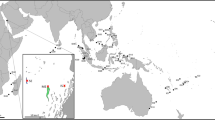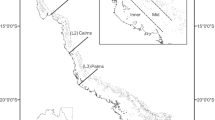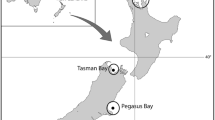Abstract
Identification of latitudinal trends in growth and maximum ages provides important insights into the vulnerability of coral reef fishes to human exploitation. Here, we sampled three species of unharvested tropical snappers from 4 locations along the tropical Western Australian coast and from the Chagos Archipelago in the central Indian Ocean. Interpretation of sectioned sagittal otoliths identified 2 species as the longest-lived tropical reef-associated fishes recorded to date, with a combined eleven specimens aged > 60 yrs, a single Lutjanus bohar aged 79 yrs and a single Macolor macularis aged 81 yrs (both from Rowley Shoals, Western Australia). These maximum ages are two decades greater than previous estimates of maximum age for reef fishes. Lifetimes of such long durations confirm the low rates of natural mortality for these species, their associated low production potential, and the need for effective systems of governance to enable sustainable harvests across the distributions of these species.

Similar content being viewed by others
References
Andrews AH, Yeman C, Welte C, Hattendorf B, Wacker L, Christl M (2019) Laser ablation-accelerator mass spectrometry reveals complete bomb 14C signal in an otolith with confirmation of 60-year longevity for red snapper (Lutjanus campechanus). Mar Freshwater Res 70:1768–1780
Atkinson D (1994) Temperature and organism size—a biological law for ectotherms? Adv Ecol Res 25:1–58
Beamish RJ, McFarlane GA, Benson A (2006) Longevity overfishing. Prog Oceanogr 68:289–302
Benthuysen JA, Oliver ECJ, Feng M, Marshall AG (2018) Extreme marine warming across tropical Australia during austral summer 2015–2016. J Geophys Res-Oceans 123:1301–1326
Burton ML, Potts JC (2017) Age, growth, and natural mortality of cubera snapper, Lutjanus cyanopterus, from the southeastern United States. Bull Mar Sci 93:815–828
Campana SE (2001) Accuracy, precision and quality control in age determination, including a review of the use and abuse of age validation methods. J Fish Biol 59:197–242
Cooper TF, O’Leary RA, Lough JM (2012) Growth of Western Australian corals in the anthropocene. Science 335:593–596
Kritzer JP, Davies CR, Mapstone BD (2001) Characterizing fish populations: effects of sample size and population structure on the precision of demographic parameter estimates. Can J Fish Aquat Sci 58:1557–1568
Longhurst A (2002) Murphy’s law revisited: longevity as a factor in recruitment to fish populations. Fish Res 56:125–131
Marriott RJ, Mapstone BD (2006) Geographic infleunces on and the accuracy and precision of age estimates for the red bass, Lutjanus bohar (Forsskål 1775): A large tropical reef fish. Fish Res 80:322–328
Marriott RJ, Mapstone BD, Begg GA (2007) Age-specific demographic parameters, and their implications for management of the red bass, Lutjanus bohar (Forsskål, 1775): a large tropical reef fish. Fish Res 83:204–215
Molony BW, Newman SJ, Joll L, Lenanton RCJ, Wise B (2011) Are Western Australian waters the least productive waters for finfish across two oceans? a review with a focus on finfish resources in the Kimberley region and North Coast Bioregion. J Roy Soc West Aus 94:323–332
Munch SB, Salinas S (2009) Latitudinal variation in lifespan within species is explained by the metabolic theory of ecology. P Natl A Sci USA 106:13860–13864
Newman SJ, Williams DMcB, Russ GR (1997) Patterns of zonation of assemblages of the Lutjanidae, Lethrinidae and Serranidae (Epinephelinae) within and among mid-shelf and outer-shelf reefs in the central Great Barrier Reef. Mar Freshwater Res 48:119–128
Newman SJ, Williams AJ, Wakefield CB, Nicol SJ, Taylor BM, O’Malley JM (2016) Review of the life history characteristics, ecology and fisheries for deep-water tropical demersal fish in the Indo-Pacific region. Rev Fish Biol Fisheries 26:537–562
NewmanWilliams SJDMcB (2001) Spatial and temporal variation in assemblages of Lutjanidae, Lethrinidae and associated fish species among mid-continental shelf reefs in the central Great Barrier Reef. Mar Freshwater Res 52:843–851
Ong JJL, Rountrey AN, Zinke J, Meeuwig JJ, Grierson PF, O’Donnell AJ, Newman SJ, Lough JM, Trougan M, Meekan MG (2016) Evidence for climate-driven synchrony of marine and terrestrial ecosystems in northwest Australia. Glob Change Biol 22:2776–2786
Ong JJL, Rountrey AN, Marriott RJ, Newman SJ, Meeuwig JJ, Meekan MG (2017) Cross-continent comparisons reveal differing environmental drivers of growth of the coral reef fish, Lutjanus bohar. Coral Reefs 36:195–206
Ong JJL, Rountrey AN, Black BA, Nguyen HM, Coulson PG, Newman SJ, Wakefield CB, Meeuwig JJ, Meekan MG (2018) A boundary current drives synchronous growth of marine fishes across tropical and temperate latitudes. Glob Change Biol 24:1894–1903
Pardo SA, Cooper AB, Dulvy NK (2013) Avoiding fishy growth curves. Methods Ecol Evol 4:353–360
Pearce AF, Feng M (2013) The rise and fall of the “marine heat wave” off Western Australia during the summer of 2010/11. J Marine Syst 111:139–156
Piddocke TP, Butler GL, Butcher PA, Stewart J, Bucher DJ, Christidis L (2015) Age and growth of mangrove red snapper Lutjanus argentimaculatus at its cool-water-range limits. J Fish Biol 86:1587–1600
Taylor BM, Choat JH, DeMartini EE, Hoey AS, Marshell A, Priest MA, Rhodes KL, Meekan MG (2019) Demographic plasticity facilitates ecological and economic resilience in a commercially important reef fish. J Anim Ecol 88:1888–1900
Taylor BM, Chinkin M, Meekan MG (2020) Teleconnections reveal that drivers of inter-annual growth can vary from local to ocean basin scales in tropical snappers. Coral Reefs 39:397–407
Wakefield C, O’Malley JM, Williams AJ, Taylor BM, Nichols RS, Halafihi T, Humphreys RL, Kaltavara J, Nicol SJ, Newman SJ (2017) Ageing bias and precision for deep-water snappers: evaluating nascent otolith preparation methods using novel multivariate comparisons among readers and growth parameter estimates. ICES J Mar Sci 74:193–203
Wakefield CB, Coulson PG, Loudon L, Newman SJ (2020) Latitudinal and sex-specific differences in growth and an exceptional longevity for the Maori snapper Lutjanus rivulatus from north-western Australia. Fish Res 230:105634
Acknowledgements
Core funding for this study was provided by the Bertarelli Foundation as part of the Bertarelli Programme in Marine Science, the Australian Institute of Marine Science, and the Department of Primary Industries and Regional Development (DPIRD), Western Australia. B.M.T. was supported by the Bertarelli Programme in Marine Science. Research in Western Australia was permitted by DPIRD and the Department of Biodiversity, Conservation and Attractions. Collection efforts were subject to animal ethics review from the University of Western Australia. We thank P. McDowell and K. Brooks for assistance with collections, and two anonymous reviewers for their feedback.
Author information
Authors and Affiliations
Corresponding author
Ethics declarations
Conflict of interest
On behalf of all authors, the corresponding author states that there is no conflict of interest.
Additional information
Publisher's Note
Springer Nature remains neutral with regard to jurisdictional claims in published maps and institutional affiliations.
Topic Editor Morgan S. Pratchett
Electronic supplementary material
Below is the link to the electronic supplementary material.
Rights and permissions
About this article
Cite this article
Taylor, B.M., Wakefield, C.B., Newman, S.J. et al. Unprecedented longevity of unharvested shallow-water snappers in the Indian Ocean. Coral Reefs 40, 15–19 (2021). https://doi.org/10.1007/s00338-020-02032-3
Received:
Accepted:
Published:
Issue Date:
DOI: https://doi.org/10.1007/s00338-020-02032-3




